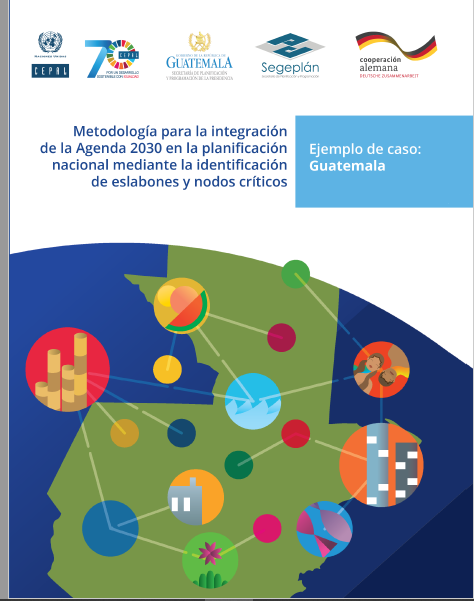Definition of the National Prioritiesfor Development: Aligning the SDGs to the National Development Plan
Description
How Guatemala integrated the SDGs into the National Development Plan, after a technical analysis determined a high level of coincidence in themes and scope between both instruments. It was carried out from 2016 to 2017.
To integrate the national and international development agenda into a more manageable set of goals and targets, in order to define a viable implementation strategy.
• National public institutions, primarily ministries and secretariats
• ECLAC
Guatemala started the process of integrating the National Development Plan (NDP) and the 2030 Agenda since 2016. The National Development Plan known as K’atun 2032, was approved in 2014, and is the country’s guideline for development in the long term. When Guatemala signed the commitment to the 2030 Agenda in 2015, it was found that the NDP and the SDGs had similar targets and even similar timelines.
In 2016, the National Urban and Rural Development Council (CONADUR) established a strategy to accomplish the SDG Agenda, based on the lessons learned in the implementation of MDGs, and taking as reference the priorities established in the National Development Plan (K’atun 2032).
Through workshops with civil society and other actors, Guatemala prioritized 17 goals, 129 targets and 200 indicators for the country.
Even though the definition of the national commitment to the 2030 Agenda was a big step, a large challenge persisted: implementing two separate long-term development agendas to fulfill national and international commitments. Therefore, Guatemala considered that finding the synergy between them would be a better effort and together with ECLAC, implemented the “nodes and links” methodology to integrate both instruments into a single development agenda.The results were 99 integrated targets and the methodology led to identifying the interlinkages between them, recognizing that the targets are woven together and actions towards one of them would impact others. The analysis implied identifying the way the different dimensions of development are related, supported by evidence and it was carried out by a team of specific technical staff with the support of CEPAL. Once those relationships were established, the nodes and links with most incidence and connections to others were deemed as strategic development targets. This means that achieving these targets would cause a “ripple effect” in advancing the achievement of the targets related to them.
These 16 Strategic Development Targets, were found to be grouped in ten themes, or “circles”. These circles represent the ten strategic areas for intervention through public policy. These have been named “National Priorities for Development”, they are:
• Social Protection and reduction of poverty,
• Access to health services,
• Access to Water and Management of Natural Resources,
• Food Security and Nutrition,
• Employment and Investment,
• Economic Value of Natural Resources,
• Institutional Strengthening,
• Security and Justice,
• Education,
• Fiscal Reform,
• Territorial Ordering
None of these Priorities can stand alone and progress in one impact others to different degrees. In 2018, the government started socializing the ten National Priorities with civil society, private sector and the Congress, among others.
The commitment of the National Urban and Rural Development Council to the subject has enabled a political push towards the implementation of the process. A positive outcome is that the experience has strengthened the role of the Council.
The existing good relationship with the ECLAC and their availability to contribute through technical assistance and financing.
The role the Secretariat of planning and programming has in relation to other institutions.
Integrating both development agendas has resulted in a more manageable pathway for implementation. It has also enriched both instruments, as the SDGs have become "nationalized" and has made Guatemala reassess how the dimensions of sustainable development must be implemented.
A joint document with ECLAC called: "Metodología para la integración de la Agenda 2030 en la planificación nacional mediante la identificación de eslabones y nodos críticos".
SDGS & Targets
Deliverables & Timeline
Resources mobilized
Partnership Progress
Feedback
Action Network


Timeline
Entity
Region
- Latin America and the Caribbean
Geographical coverage
Photos

Website/More information
Countries

Contact Information
Miguel Angel Moir, Secretary of Planning and Programming of the Presidency
